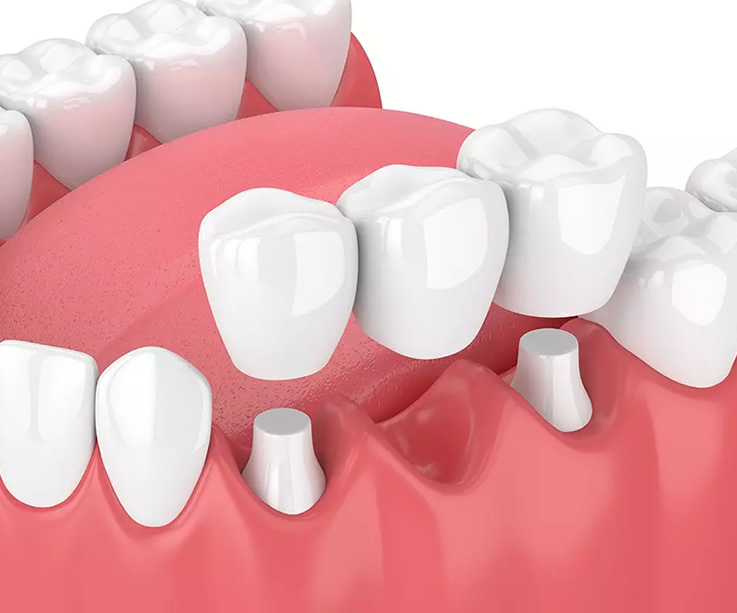If you happen to have a crack or chip in your teeth, porcelain crowns and veneers can be used to restore your smile and preserve the function of your damaged teeth.
Dental Crowns are used to strengthen and restore a tooth to it’s full functionality and appearance. A tooth crown, also referred to as a cap, is custom made to fit over your entire tooth after the dentist has prepared it. Crowns essentially protect a tooth and hold it together. A dental crown is usually made out of acrylic, or porcelain that has been fused to metal, or plain porcelain, to with stand biting pressure. Crowns can be used in cosmetic dentistry to treat teeth that are poorly shaped, badly decayed, fractured, chipped or discoloured. Dental Crowns are also used in conjunction with implants to replace a lost tooth.
A Dental Bridge is used to replace one or more missing teeth. A false tooth, known as a pontic, is fused between two porcelain crowns to fill in the area left by a missing tooth. The two crowns that hold it in place are attached onto your teeth on each side of the missing tooth. This is a fixed bridge.
Importance of dental crowns and bridges
Dental Crowns and Bridges help correct some bite issues which may improve your speech and chewing ability. Dental Crowns and Bridges along with good dental hygiene, oral care and regular dental checkups may last for many years.
Is it right for you?
Crowns may be used to protect a cracked tooth, restore functionality of a tooth with excessive decay, or replace a preexisting crown. The purpose of a dental crown is to encase a needy tooth with a custom-designed material. If you have a space from a missing tooth, a Dental Bridge will be custom made to fill in the space with a false tooth. The false tooth is attached by the bridge to the two other teeth around the space – bridging them together.
Crowns
Why would I need a Crown?
A Dental Crown is often the best solution to replace large, worn fillings, repair a tooth that has cracked, has a very large cavity or has undergone Root Canal treatment. The crown covers and provides increased protection for the natural tooth beneath it. Crowns are also used to improve the appearance of natural teeth that are malformed, malpositioned or discoloured.
How is the crown fitted?
When you and your dentist are happy with the fit and appearance of the new crown it will be fixed in place with special dental cement or adhesive. The cement forms a seal to hold the crown in place.
How long does the treatment take?
You will need to have at least two visits: the first for the preparation, impression, shade taking and fitting the temporary crown; and the second to fit the permanent crown. There will usually be about 1 to 2 weeks in between appointments.
Fitting a crown requires at least two appointments. During your first visit, the tooth is prepared for the crown, an impression or mould is made of the tooth, and a temporary crown is placed over the prepared tooth. At the subsequent visit, the temporary crown is removed and the final crown is fitted and adjusted and cemented into place.
How long will the Crown last?
How long your crown lasts depends on how well you look after it. The crown itself cannot decay, but decay can start where the edge of the crown joins the tooth. Therefore, it is important to keep this area just as clean as you would your natural teeth in order to prevent decay affecting the crown. On average, dental crowns last between 5 and 15 years. You should avoid such habits as grinding or clenching your teeth, chewing ice, biting your fingernails and using your teeth to open packaging. Properly cared for crowns should last for many years. Your dentist will be able to tell you how long the crown may be expected to last.
What’s Involved?
During the first appointment, diagnostic moulds and x-rays are taken to evaluate the tooth. This will determine if the tooth requires any treatment prior to starting the crown. The second appointment will involve shaping and preparing the tooth for the crown. An impression (or a “mould”) is taken off the tooth, and from it a model is poured. Your crown is made from this model, (it can take 1 – 2 weeks) and during this time a temporary crown is placed on the tooth. The temporary crown is designed to protect your tooth and gum between visits, but is not durable enough to last a long time. When your crown is ready, your dentist will remove the temporary crown, clean away the temporary cement and check the fit of the new crown. Once everything is ready, the crown will then be cemented to your tooth. Once your new tooth crown is in place, you may experience a mild sensitivity to hot or cold temperatures on the tooth for several weeks. This is only temporary and should subside on its own.
Bridges
What is a dental bridge?
Dental bridges literally bridge the gap created by one or more missing teeth. A bridge is made up of two crowns for the teeth on both side of the gap – these two anchoring teeth are called abutment teeth – and a false tooth/teeth in between. These false teeth are called pontics and can be made from gold, alloys, porcelain or a combination of these materials. Dental bridges are supported by natural teeth or implants.
Why would I need a bridge?
- Replacement tooth, or teeth
- Natural, or improved, appearance
- Support and protection to compromised teeth
What’s Involved?
This procedure requires two appointments, as per crowns. At the first appointment the teeth are prepared to make room for the supporting crowns. An impression (or, mould) is then taken for production at the laboratory, and a plastic temporary bridge fitted for the interim period. Laboratory production takes approximately 2 weeks. At the subsequent visit, the temporary bridge is removed and the final bridge is permanently cemented into place. Any surgical or invasive procedure carries risks. Before proceeding, you should seek a second opinion from an appropriately qualified health practitioner.






